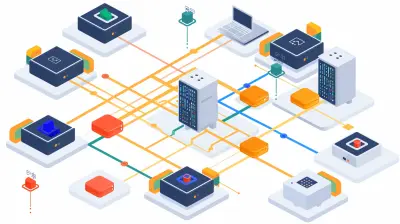The Shift to DevSecOps: Integrating Security into the DevOps Pipeline
5 February 2025
In today’s fast-paced tech world, the demand for rapid software releases has skyrocketed. But, while speed is essential, security can’t be an afterthought. You know the drill: It’s all fun and games until a security breach brings everything to a screeching halt. The solution? Enter DevSecOps — the natural evolution of DevOps that integrates security directly into the development pipeline.
Gone are the days when security was something tacked on at the end of development, like an after-market spoiler on a car. Instead, we're now shifting to a "baked-in" approach where security is an integral part of every step in the process. So, buckle up as we dive deep into the world of DevSecOps!

What Exactly is DevSecOps?
Before we get ahead of ourselves, let’s break down what DevSecOps really is. In simple terms, DevSecOps is a fusion of Development (Dev), Security (Sec), and Operations (Ops). At its core, the idea behind DevSecOps is to make security a shared responsibility throughout the entire software development lifecycle, rather than leaving it as an afterthought.Traditionally, development teams focused on writing code and pushing features while security teams were left to play catch-up, trying to find and fix vulnerabilities after the fact. This reactive approach often led to delays and frustration. DevSecOps flips the script by integrating security practices into the continuous integration/continuous delivery (CI/CD) pipeline, ensuring that security checks happen throughout the process.
Think of it as a factory assembly line where, instead of waiting until the end to check for defects, you inspect every piece at each stage. That’s the beauty of DevSecOps!

Why Is DevSecOps So Important?
Let’s be real: Security breaches are no joke. In an era where cyberattacks are becoming more sophisticated by the day, organizations can’t afford to leave security to chance. The stakes are high. A single vulnerability in your software could lead to catastrophic data breaches, loss of customer trust, and hefty fines from regulatory bodies.Here’s where DevSecOps comes in like the superhero we didn’t know we needed. By integrating security into the DevOps pipeline, companies can catch potential vulnerabilities early, often reducing the cost and effort needed to fix them. It's a proactive approach to cybersecurity, which is always better than reacting to a disaster after it happens.
The Cost of Neglecting Security
Did you know that fixing a security issue in the design phase is 30 times cheaper than fixing it after the software has been deployed? And yet, countless companies still neglect to integrate security early in the development process. When problems are caught late, it not only slows down the release cycle but can also result in expensive and time-consuming fixes.Imagine building a house and waiting until the very end to check if the foundation is solid. Sounds risky, right? DevSecOps prevents this by ensuring that every code release is secure from the get-go.

The Key Principles of DevSecOps
So, how do you actually implement DevSecOps? It’s not just about sprinkling a bit of security here and there. There are specific principles that guide this approach:1. Shift Left Mentality
The term “shift left” gets thrown around a lot in DevSecOps circles. But what does it really mean? Essentially, it’s about moving security checks to the earlier stages of the development lifecycle. By doing this, vulnerabilities are caught early when they’re easier (and cheaper) to fix.Instead of thinking of security as the final boss that you face at the end of the development journey, it becomes a companion that walks with you every step of the way. This requires collaboration between developers, security experts, and operations teams right from the start.
2. Automation is Key
One of the biggest benefits of DevOps is its focus on automation, and DevSecOps takes this up a notch. Automated security tools can be integrated into the CI/CD pipeline, running checks on every code commit, build, and deployment.These tools scan for vulnerabilities in real-time, ensuring that nothing slips through the cracks. Plus, automation helps maintain speed and agility, which are crucial in today’s competitive software environment. After all, no one wants a security check to slow down the whole train, right?
3. Collaboration Across Teams
DevSecOps requires a culture shift. Developers, security professionals, and operations teams (often referred to as "SecOps") need to work together as one cohesive unit. No more throwing things over the fence and hoping they stick. Security becomes everyone’s responsibility.By fostering open communication and collaboration between teams, organizations can break down the traditional silos that often exist between development, security, and operations. This will lead to faster, more secure releases. It’s like going from a relay race, where each team works in isolation, to a synchronized team sport where everyone works together.
4. Continuous Monitoring
Security isn’t something you check off a list once and move on. It’s an ongoing process. DevSecOps emphasizes the importance of continuously monitoring applications and infrastructure for potential threats.By using real-time threat intelligence and security analytics, teams can stay ahead of potential attacks and respond quickly to vulnerabilities. It’s like having a security guard on duty 24/7, constantly on the lookout for trouble.

The Benefits of Adopting DevSecOps
If you’re still wondering whether DevSecOps is worth the effort, let’s break down some of the key benefits:1. Faster Time-to-Market
By integrating security directly into the development pipeline, you can eliminate the bottlenecks that traditionally slow down releases. When security issues are caught early, there’s less back-and-forth between teams, allowing you to launch products faster without compromising on safety.2. Improved Security Posture
When security is woven into every step of the development process, you’re less likely to encounter major vulnerabilities later on. DevSecOps ensures that your software is secure from the ground up, reducing the risk of costly breaches.3. Cost Savings
As mentioned earlier, fixing security issues early in the development cycle is far cheaper than addressing them post-release. With DevSecOps, you can potentially save a ton of money by avoiding the costly consequences of late-stage security fixes and breaches.4. Enhanced Collaboration
DevSecOps encourages better communication and collaboration across teams, breaking down silos and fostering a culture of shared responsibility. This not only improves security but also helps build trust and efficiency within the organization.5. Better Compliance
With the growing number of regulations and standards around data security (like GDPR, HIPAA, and PCI-DSS), staying compliant is more important than ever. DevSecOps can help you ensure that security controls are in place throughout the development process, making it easier to meet regulatory requirements.Challenges in Adopting DevSecOps
Of course, it’s not all sunshine and rainbows. Implementing DevSecOps comes with its own set of challenges. Here are some of the common hurdles you might face:1. Cultural Resistance
Change is hard — especially when it comes to altering established workflows. Some teams may resist integrating security into their DevOps practices, especially if they believe it will slow things down. Overcoming this resistance requires strong leadership and a focus on the long-term benefits of DevSecOps.2. Tool Overload
With so many security tools available, it can be overwhelming to figure out which ones to use. The key is to choose tools that integrate seamlessly with your existing DevOps pipeline and don’t create unnecessary friction.3. Skills Gap
Not every developer is a security expert, and that’s okay. However, for DevSecOps to work, teams need to be trained in security best practices. This might require investing in training programs or hiring professionals with the right skill set.
How to Get Started with DevSecOps
If you’re ready to make the shift to DevSecOps, here are a few steps to help you get started:1. Start Small
You don’t have to overhaul your entire development process overnight. Start by integrating security checks into one part of your pipeline and then gradually expand from there.2. Invest in Automation
Automating security tasks is crucial for maintaining speed and efficiency. Look for tools that can automatically scan for vulnerabilities, perform static code analysis, and monitor for potential threats.3. Foster Collaboration
Encourage open communication between your development, security, and operations teams. Regular meetings and shared goals can help align everyone’s efforts and ensure that security is a priority from the start.4. Train Your Team
Provide training to ensure that everyone understands the security tools and practices you’re implementing. This will help your team feel more comfortable with the changes and ultimately lead to better outcomes.The Future of DevSecOps
As the cybersecurity landscape continues to evolve, the shift to DevSecOps will likely accelerate. With the rise of threats like ransomware, supply chain attacks, and zero-day vulnerabilities, organizations will need to adopt a proactive approach to security.In the future, we can expect even more advanced automation tools, tighter integration between security and development processes, and an increased focus on continuous monitoring and threat detection. DevSecOps is here to stay, and those who embrace it early will be better positioned to navigate an increasingly complex digital world.
Conclusion
The shift to DevSecOps represents a fundamental change in how we approach software development and security. By integrating security into the DevOps pipeline, organizations can improve their security posture, reduce costs, and deliver software faster.While it may take time to fully implement, the benefits far outweigh the challenges. So, if you haven’t already made the shift to DevSecOps, now’s the time to start. After all, in today’s world, security isn’t just an option — it’s a necessity.
all images in this post were generated using AI tools
Category:
Software DevelopmentAuthor:

Adeline Taylor
Discussion
rate this article
17 comments
Liora Roberson
Great insights on the importance of integrating security into the DevOps pipeline! It’s refreshing to see a focus on DevSecOps, as it’s crucial for creating secure software. I appreciate the emphasis on collaboration among teams—this shift truly strengthens the entire development process. Looking forward to more discussions on this topic!
March 10, 2025 at 8:41 PM

Adeline Taylor
Thank you for your thoughtful comment! I'm glad you found the discussion on DevSecOps valuable. Collaboration is key to enhancing security in our development processes. Looking forward to more insights together!
Hope Harmon
Ah, yes, because nothing says “fun” like squeezing security into the DevOps pipeline! Can’t wait for the thrilling game of “Who broke the build… again?”
February 25, 2025 at 4:13 AM

Adeline Taylor
I understand the hesitation! Integrating security may seem challenging, but it ultimately leads to a more robust and reliable product. Embracing DevSecOps can enhance collaboration and help us all build better software.
Izaak Daniels
In the dance of code, where shadows play, DevSecOps weaves security’s sway. Bridging worlds, ensuring trust, In every line, we code with must. Safety and speed, a future discussed.
February 24, 2025 at 9:07 PM

Adeline Taylor
Thank you for capturing the essence of DevSecOps so beautifully! Your poetic take highlights the crucial balance between security and agility in our development processes.
Susan McDonald
DevSecOps: where security shakes hands with DevOps and says, 'Let’s build safe and sound!' It’s like adding sprinkles to your coding cake—sweet, colorful, and oh-so-important! 🍰🔒
February 22, 2025 at 6:00 AM

Adeline Taylor
Absolutely! DevSecOps enhances our DevOps process by ensuring security is a key ingredient from the start—making our "coding cake" not just delicious but also secure! 🍰🔒
Will McAdams
This article highlights the essential shift towards DevSecOps, emphasizing that integrating security early in the DevOps process is crucial for sustainable software development.
February 21, 2025 at 8:12 PM

Adeline Taylor
Thank you for your insight! I completely agree—integrating security early is vital for creating robust and sustainable software.
Catherine Nguyen
Securing code: because hackers love playgrounds too!
February 21, 2025 at 5:35 AM

Adeline Taylor
Absolutely! Integrating security into the DevOps pipeline ensures our playgrounds are safe for innovation, helping to close vulnerabilities before they can be exploited.
Izaak Campbell
DevSecOps enhances security by embedding it within the DevOps pipeline, fostering collaboration and minimizing risks throughout development.
February 19, 2025 at 5:56 AM

Adeline Taylor
Absolutely! Integrating security into the DevOps pipeline not only strengthens security measures but also promotes collaboration, ensuring risks are addressed early and effectively.
Matilda Rios
Great insights! Essential shift for robust software security. Thank you!
February 18, 2025 at 7:48 PM

Adeline Taylor
Thank you for your feedback! I'm glad you found the insights valuable.
Natalie Carey
Embracing DevSecOps transforms our approach to development, ensuring security is a priority. Together, we can build safer, more resilient software!
February 18, 2025 at 3:59 AM

Adeline Taylor
Thank you! Embracing DevSecOps truly enhances our development processes by prioritizing security, leading to more resilient software for everyone.
Luna Henderson
Great insights! Integrating security into the DevOps pipeline is essential for modern software development. Emphasizing security from the outset helps mitigate risks and fosters a culture of accountability and proactive problem-solving.
February 17, 2025 at 4:05 AM

Adeline Taylor
Thank you! I completely agree—prioritizing security in the DevOps pipeline not only enhances risk management but also cultivates a more responsible development culture.
Cynthia Riley
In the dance of code, security waltzes in—DevSecOps, a harmony reborn.
February 16, 2025 at 4:49 AM

Adeline Taylor
Thank you! Emphasizing security in DevOps truly creates a more resilient and harmonious development process.
Myles Fry
Embracing DevSecOps is essential; integrating security early in the DevOps pipeline fortifies software against evolving threats.
February 15, 2025 at 9:28 PM

Adeline Taylor
Absolutely! Early integration of security in the DevOps pipeline is crucial for building resilient software that can effectively counter emerging threats.
Sadie Maddox
Finally! Because who doesn’t love extra layers of complexity in their already chaotic workflows?
February 12, 2025 at 5:05 AM

Adeline Taylor
I understand the sentiment! Integrating security into DevOps can seem complex, but it's essential for a more robust and secure workflow.
Phoebe Wright
Because who needs security? Let’s live dangerously!
February 11, 2025 at 8:25 PM

Adeline Taylor
Security is essential for sustainable development. Embracing DevSecOps ensures we build safely while innovating rapidly. Let's prioritize security along with speed!
Ethan Rosales
The integration of security into the DevOps pipeline is crucial for modern software development. By adopting DevSecOps, organizations can enhance resilience against threats while maintaining agility, ultimately fostering a culture of shared responsibility.
February 9, 2025 at 9:32 PM

Adeline Taylor
Thank you for your insightful comment! You’re absolutely right—integrating security into the DevOps pipeline through DevSecOps not only enhances resilience but also promotes a culture of shared responsibility that is essential for modern software development.
Quillan McFee
Great read! Embracing DevSecOps is like adding a safety net to a thrilling tightrope walk—essential for balancing speed with security. Let’s keep innovating while keeping our code and users safe! 🚀🔐
February 9, 2025 at 5:27 AM

Adeline Taylor
Thank you! Absolutely, integrating security into DevOps is crucial for ensuring both innovation and safety. Let's keep pushing the boundaries together! 🚀🔐
Aria Cantu
Great insights on DevSecOps! Integrating security into the DevOps pipeline is essential for building robust applications. Keep up the fantastic work!
February 8, 2025 at 8:15 PM

Adeline Taylor
Thank you! I'm glad you found the insights valuable. Integrating security is indeed crucial for robust application development!
MORE POSTS

How Machine Learning is Revolutionizing eCommerce Personalization

The Rise of AI in Modern Programming Languages

How Machine Learning is Redefining Business Intelligence and Analytics

Building Ethical Machine Learning Models: Challenges and Best Practices

The Best Monitors for Graphic Designers: Enhancing Color Accuracy

How to Clean and Maintain Your Wireless Earbuds for Optimal Performance

The Growth of Biometric Security in Consumer Gadgets

The Role of Quantum Computing in Solving Complex Optimization Problems

Building Resilient Systems with Fault-Tolerant Architectures

How AI in Healthcare Gadgets is Saving Lives

Quantum Computers vs Classical Computers: What's the Difference?